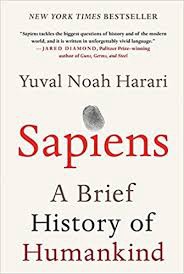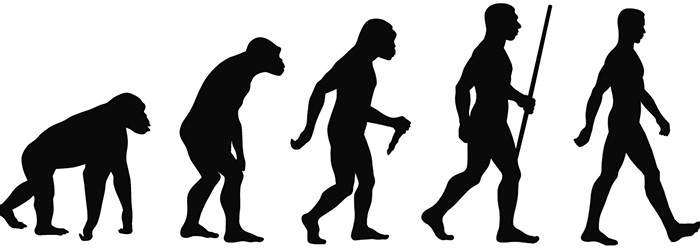Sapiens: A Brief History of Humankind

Sir Francis Bacon said that some books are to be tasted, others to be swallowed, and some few to be chewed and digested. This masterpiece by Yuval Noah Harari squarely lies in the last category.
There’s no way I can do this book any justice by trying to review it. Instead, I’ll mostly leave you with a few of my favorite quotes straight from the book. I hope that’ll convince you enough to buy and read it.
The Cognitive Revolution
Two hundred thousand years ago, Homo sapiens evolved in East Africa. We were an animal of no special significance. To be sure, we were not the the only humans to walk this planet either. Homo Neanderthalensis, Homo Erectus, Homo Habilis, etc. were all as “human” as well. Today, only we survive. Homo sapiens try to forget that we’ve been responsible for extinction of all our fellow human species. So much so that we draw Human “evolution” illustrations like the one below as if one came after another. This is a myth.

How were we so successful? The Cognitive Revolution started with the development of a massive human brain 70,000 years ago. No one really understands what first triggered the development of our species’ extraordinary intelligence. This new intelligence not just gave us speech, but also the ability to create myths. Speech is effective for gossiping within small groups, of say, up to 150 or so. Gossiping may seem frivolous, but our unique language was supple enough that we could gossip and talk behind each others’ backs for hours, thereby leading to more effective groups where people knew who to trust. Our chimpanzee friends couldn’t do so.
But more importantly, the Cognitive Revolution enabled us to create shared myths like gods and religion that made it possible for us to cooperate in networks far larger than ever possible before. Two strangers who believe in a shared myth can cooperate effectively. Any large-scale human cooperation — whether a modern state, a medieval church, an ancient city or an archaic tribe — is rooted in common myths that exist only in people’s collective imagination. This is powerful.
It took us another 40,000 years since the cognitive evolution started to drive Neanderthals to extinction. It took another 27,000 years after that for extinction of Homo floresiensis, making Homo sapiens the only surviving human species. This was as recent as only 13,000 years ago. This is the power of ghosts and fairies, of heaven and hell.
During this time, Sapiens also moved out and settled the rest of the world for the first time. We usually imagine our ancestors lived in harmony with the nature. Nothing could be farther from the truth. For instance, 16,000 years ago, Sapiens settled America. Within 2,000 years, we drove 84 of America’s 107 genera of mammals weighing over 200 pounds to extinction. We have always been the “deadliest species in the annals of biology” and remain to be so. It’s not that we’ve become cruel overnight and are causing mass extinctions only now. It’s what we do. Remember, Noah’s Ark is a myth too.
The Agricultural Revolution
About 12,000 years ago, we started domesticating plants and animals. Before Agricultural Revolution, for 2.5 million years, we fed ourselves by gathering plants and hunting animals that lived and bred without our intervention. This afforded us a lifestyle that fed us amply and supported a rich world of social structures, religious beliefs and political dynamics. About 10,000 years ago, we started devoting almost all our time and effort to manipulating the lives of a few animal and plant species in the hope of obtaining more fruit, grain and meat.
The Agricultural Revolution certainly enlarged the sum total of food at the disposal of mankind, but the extra food did not translate into a better diet or more leisure. Rather, it translated into population explosions and pampered elites. The average farmer worked harder than the average forager, and got a worse diet in return. The Agricultural Revolution was history’s biggest fraud.
10,000 years ago, wheat was just a wild grass, one of many, confined to a small range in middle east. Within a couple of millennia, humans in many parts of the world were doing little from dawn to dusk other than taking care of their wheat plants. The new agricultural tasks required so much time that people were forced to settle permanently next to their wheat fields. We did not domesticate wheat. It domesticated us.
Now that you could feed and cram thousands into a village, and millions into a kingdom, mere food surplus wasn’t enough to get everyone to cooperate with each other. How do you divide the land and water? How do you settle disputes and conflicts? How do you act in times of drought or war? Next up, was birth of imagined orders like Christianity, democracy and capitalism. To make them believable, these imagined orders are
- embedded in the material world,
- shape our desires, and
- are inter-subjective: they exist within the communication network linking the subjective consciousness of many individuals.
When it comes to shaping our desires:
Like the elite of ancient Egypt, most people in most cultures dedicate their lives to building pyramids. Only the names, shapes and sizes of these pyramids change from one culture to the other. They may take the form, for example, of a suburban cottage with a swimming pool and an evergreen lawn, or a gleaming penthouse with an enviable view. Few question the myths that cause us to desire the pyramid in the first place.
Another invention that helped us organize in mass-cooperation networks was writing. The memory overload created by having to keep track of vast amounts of information was solved with the invention of the script. But whereas writing was born as a maidservant of human consciousness, it has increasingly become its master. Our computers have trouble understanding how Homo sapiens talks, feels and dreams. So we are teaching Homo sapiens to talk, feel and dream in the language of numbers, which can be understood by computers.
These imagined orders were neither neutral nor fair. From race to gender, there’s no justice in history. Why is it that for the species whose success depends above all on cooperation, individuals who are supposedly less co-operative (men) control individuals who are supposedly more co-operative (women)? If, as is being demonstrated so clearly, the patriarchal system has been based on unfounded myths rather than on biological facts, what accounts for the universality and stability of this system? We don’t really know. (This chapter was indeed one of the hardest to read.)
The Unification of Mankind
The arrow of history points towards unification of mankind. During the last three millennia, people made more and more ambitious attempts to realize that global vision. This section discusses how money, empires and universal religions spread, and how they laid the foundations of the united world today.
We begin with the story of the greatest conqueror in history, a conqueror possessed of extreme tolerance and adaptability, thereby turning people into ardent disciples. This conqueror is money. People who do not believe in the same god or obey the same king are more than willing to use the same money. Osama bin Laden, for all his hatred of American culture, American religion and American politics was very fond of American dollars.
Money succeeded where gods and kings failed. It’s based on universal convertibility and universal trust. With money, you can turn land into loyalty, justice into health, and violence into knowledge. With money, any two people can cooperate on any project.
But it’s impossible to understand the unification of humankind as a purely economic process. The role of the imperial cycle and of religions cannot be overlooked.
The last 300 years are often depicted as an age of growing secularism, in which religions have increasingly lost their importance. If we are talking about theist religions, this is largely correct. But if we take into consideration natural-law religions, modernity turns out to be an age of intense religious fervor, unparalleled missionary efforts, and the bloodiest wars of religion in history. The modern age has witnessed the rise of a number of new natural-law religions, such as liberalism, Communism, capitalism, nationalism and Nazism. These creeds do not like to be called religions, and refer to themselves as ideologies. But this is just a semantic exercise. If a religion is a system of human norms and values that is founded on belief in a superhuman (not supernatural) order, then Soviet Communism was no less a religion than Islam.
In the last century, we have witnessed the rise of three humanist religions in particular — liberal humanism, socialist humanism and evolutionary humanism (Nazism). Today, liberalism, or the belief that every human life is equally important, is the dominant religion. Billions upon billions of dollars have been pledged to this new church by the wealthiest billionaires like Bill Gates and Warren Buffet.
The Scientific Revolution
The last section of the book focuses on how 500 years ago, “humankind admitted its ignorance and began to acquire unprecedented power.” Fueled by the twin forces of imperialism and capitalism, the last 500 years have witnessed an unprecedented growth in human power. After all, in this time period, human population has increased fourteen-fold, production 240-fold, and energy consumption 115-fold.
Modern science is based on willingness to admit ignorance, on centrality of observations and mathematics, and acquiring new powers and not just creating new theories. This led to the Industrial Revolution around 200 years ago, replacing family and community with the state and market. And of course, massive extinction of plants and animals as usual.
The Scientific Revolution was fueled by Imperialism. Scientists have provided the imperial project with practical knowledge, ideological justification and technological gadgets. The conquerors returned the favor by providing scientists with information and protection, supporting all kinds of strange and fascinating projects and spreading the scientific way of thinking to the far corners of the earth. But behind the meteoric rise of both science and empire lurks one particularly important force: Capitalism. In particular, the increasing willingness to lend credit to explorers and entrepreneurs got the flywheel of the modern economy spinning.
Today, we have transcended the boundaries of our planet, created nuclear weapons that threaten our own survival (or prevented another world war, depending on how you look at them), and shape organisms by intelligent design rather than natural selection. Where are we headed? Genetic engineering, artificial intelligence and the possibility of the “singularity” are the main topics of Homo Deus, the sequel to this book, which I’ll cover next week.
This review was the hardest and the easiest to write at the same time. On the one hand, there’s no way I can capture the vivid and memorable language it is written in (And I cannot quote the whole book either.) On the other, I’m sure no matter which parts I focus on, this book is filled with so many perspective shaping ideas and thoughts that even a mere glimpse at them through this post would’ve taught you something new.
You can skip reading every other book as long as you don’t skip this one. Here’s the Amazon Smile Link.
This is #14 in a series of book reviews published weekly on this site.
